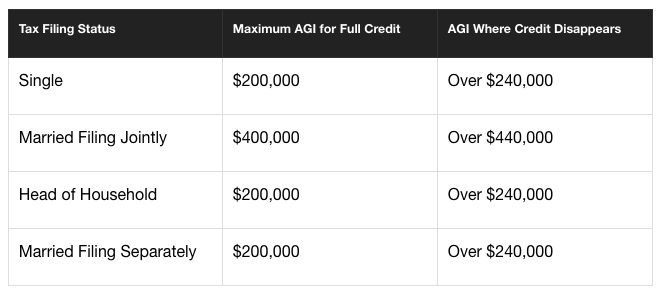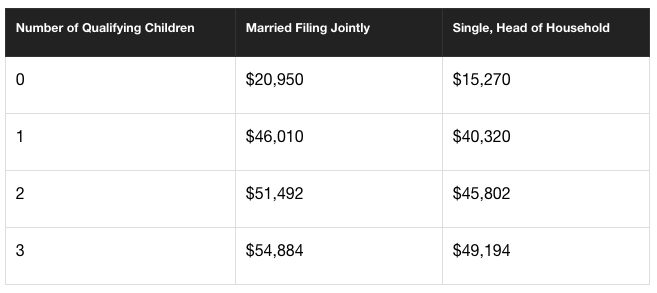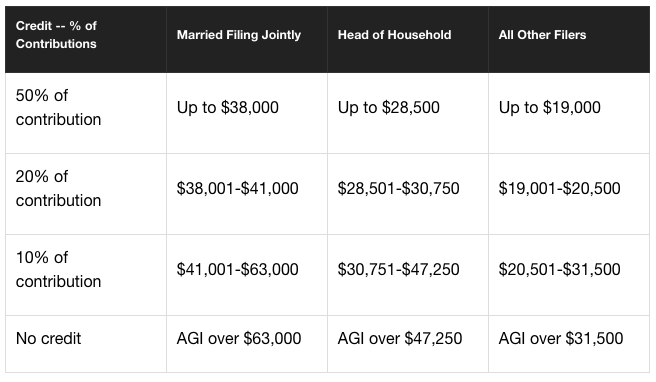9 Tax Credits You Need To Know

A tax credit can be an extremely lucrative form of tax break for Americans. Many families save thousands of dollars each year thanks to credits, and many of them survived the Tax Cuts and Jobs Act and can still be used. While the act made the most significant overhaul to the U.S. tax code in three decades, eliminating or reducing several popular tax deductions, the majority of available tax credits have been retained or even expanded.
With that in mind, here's a discussion of what a tax credit is, nine of the most commonly used tax credits, and the details behind each one. To be clear, the information presented here, such as income limits, is for the 2018 tax year, which is the return you'll likely file during 2019.
What is a tax credit?
One of the most important things to know when tax planning is the difference between a tax credit and a tax deduction. A tax deduction reduces the amount of your taxable income, which is then applied to the current marginal tax brackets. On the other hand, a tax credit is a dollar-for-dollar reduction in the amount of tax you owe, or an increase in the amount that will be refunded to you.
For this reason, tax credits are generally superior to tax deductions. In other words, a $500 tax credit is far more valuable than a $500 deduction. If you are in the 28% tax bracket, for example, a $500 deduction would save you $140. Not too bad, but far from the $500 a credit would keep in your pocket.
Refundable versus nonrefundable tax credits
Another important distinction is the difference between refundable and nonrefundable tax credits. Both reduce your tax liability dollar for dollar. However, a refundable tax credit can continue to reduce your tax liability beyond zero, while a nonrefundable credit cannot.
As a simplified example, let's say that when you do your 2018 taxes, you find that your federal income tax for the year is $1,500 before any credits are applied. If you are entitled to a $2,000 refundable tax credit, the entire credit can be applied and your tax liability will be negative $500, meaning that you'll get $500 refunded to you.
On the other hand, if you are entitled to a $2,000 nonrefundable credit, it can erase your $1,500 in federal income tax liability, but no more. You won't owe any federal income tax for 2018, but you won't get any additional refund.
Nine tax credits all Americans need to know
There are many tax credits allowed under current U.S. tax law, ranging from the common to the extremely rare. With that in mind, here are nine of the tax credits Americans are most likely to qualify for when they file their taxes in 2019 and beyond, followed by some key details about each one.
The Child Tax Credit
One of the biggest changes made to the U.S. tax code by the Tax Cuts and Jobs Act is the doubling of the Child Tax Credit and the increase to its associated income limitations.
The Child Tax Credit is available to be claimed for qualifying children under age 17. A qualifying child generally means one who derives the majority of his or her financial support from you, and just to clarify the age restriction, the child for whom the credit is claimed must be under age 17 at the end of the tax year. So, for your 2018 taxes, your child must have been under 17 on Dec. 31, 2018, in order for you to be eligible for the credit. (Note: If you have dependent children ages 17 or older, they may still qualify for the Credit for Other Dependents, which we'll get to next.)
If they qualify, the Child Tax Credit is worth as much as $2,000 per qualifying child. And, you can claim the credit for every qualifying dependent child you have. If you have three children under 17, for example, you could get a Child Tax Credit of as much as $6,000.
It's also important to point out that the Child Tax Credit is partially refundable – up to $1,400 of the credit is refundable for each qualifying child on your 2018 tax return.
Notice that I said the credit is worth "as much as" $2,000 per child. This is because the Child Tax Credit is income-restricted. If your adjusted gross income, or AGI, is above a certain threshold, your ability to claim the Child Tax Credit begins to phase out. Also, above another AGI threshold, your ability to take the credit disappears completely. Here's a guide to the phaseout thresholds for the 2018 tax year that you can use when filing your tax return in 2019:

The Credit for Other Dependents
In addition to the lucrative Child Tax Credit, there's also a tax credit available for taxpayers with other dependents. For example, if you have a child who is over the age of 16, they are now considered an "other dependent" as a result of the Tax Cuts and Jobs Act. The same is true if you have an aging parent who lives with you and gets most of their financial support from you.
Starting with the 2018 tax year, there is a tax credit of up to $500 for other dependents. Unlike the Child Tax Credit, this is a nonrefundable credit, meaning that it cannot reduce your tax liability beyond zero. And, the phase-out thresholds for the Credit for Other Dependents are the same as for the Child Tax Credit.
Child and Dependent Care Credit
The Child and Dependent Care Credit is a nonrefundable tax credit designed to make it easier for working parents to afford child care.
In order to take the credit, the following qualifications must be met:
- You must have earned income during the tax year. For joint returns, both spouses must have earned income. There's an exception if you (or your spouse) are disabled, or were a full-time student.
- You can't use the Married Filing Separately status.
- You paid for child care for a child under age 13, or for a disabled dependent of any age. The child care provider cannot be someone who can claim as a dependent -- for example, you can't pay your 17-year-old child to care for your five-year-old child and take the credit for those expenses.
- You paid the child care expenses so you (and your spouse) could work, look for a job, or go to school. Again, if you were disabled, this requirement doesn't apply.
If you qualify, the Child and Dependent Care Credit is worth 20% to 35% of your qualifying expenses, depending on your adjusted gross income. If your income is $15,000 or less, you qualify for 35%. The percentage drops by one for every $2,000 in income above $15,000. So, for an AGI between $19,000 and $21,000, your Child and Dependent Care Credit would be 33% of qualifying expenses. This maxes out at a 20% rate for AGI greater than $43,000. There is no upper income limit for the Child and Dependent Care Credit.
Your applicable percentage is applied to as much as $3,000 in qualifying expenses for one child, or to $6,000 in expenses for two or more children.
As an example, if your AGI is $50,000 for the year and you paid $4,000 in child care expenses for one child, you would be able to claim a credit for 20% of $3,000 of those expenses, or a $600 credit.
Earned Income Tax Credit (EITC)
The Earned Income Tax Credit, or EITC, is designed to lower taxes for workers with lower incomes. The amount of the credit depends primarily on the size of the taxpayer's family. For 2018, the EITC is worth as much as:
$519 for families with no qualifying children
$3,461 for families with one qualifying child
$5,716 for families with two qualifying children
$6,431 for families with three or more qualifying children
As I mentioned, the EITC is income-restricted. Here's a look at the maximum income limits for the 2018 tax year:

Finally, if a taxpayer has more than $3,500 in investment income -- dividends, for example -- they are automatically ineligible for the EITC.
The Retirement Savings Contributions Credit (The Saver's Credit)
There's a tax credit designed to encourage Americans with modest incomes to save money for retirement, known as the Retirement Savings Contributions Credit, or informally as the Saver's Credit.
If you contribute to a tax-advantaged retirement account such as a traditional or Roth IRA, 401(k), 403(b), Thrift Savings, SEP-IRA, or 457, just to name some popular examples, you could literally get free money for saving for retirement.
The Saver's Credit is worth 10%, 20%, or 50% of as much as $2,000 in retirement savings contributions for those who qualify. If you're married, both spouses can take advantage. This makes the maximum credit $1,000 for individuals and $2,000 for couples, depending on income. And, this is a nonrefundable credit. (Note: From this point on, assume all credits are nonrefundable unless otherwise noted.)
For the 2018 tax year, here are the various income thresholds for the Saver's Credit:

The American Opportunity Tax Credit (AOTC)
There are two tax credits available for Americans who pay college tuition, and the first one is the American Opportunity Tax Credit, or AOTC. This is the more potentially lucrative of the two, but it's also the more difficult to qualify for.
First, the qualifications. In order to qualify for the American opportunity credit, here are the criteria:
- The student must be pursuing a degree, certificate, or some other type of credential.
- The student needs to be enrolled at least half-time for one or more academic periods during the tax year. While the definition of half-time varies by school, a common definition is at least six credit hours in a semester.
- The student cannot have completed four years of post-secondary education at the beginning of the tax year. The AOTC is designed to provide a tax benefit for the duration of a standard four-year degree program, and even if a student takes longer to finish a bachelor's degree, the AOTC is capped at four years.
- The AOTC has income restrictions. To claim the full credit, the taxpayer (not the student) must have modified AGI (MAGI), which is a form of AGI specific to certain tax breaks of $160,000 or less if filing a joint return, or $80,000 or less for other filing statuses. The ability to claim the credit disappears entirely above MAGI of $180,000 and $90,000, respectively.
For taxpayers who qualify, the AOTC can be very valuable. The credit is worth 100% of the first $2,000 of qualified expenses, and 25% of the next $2,000, for a maximum of $2,500 per student. And, as much as $1,000 of the credit is refundable even if your tax liability is zero.
The Lifetime Learning Credit
In many ways, the Lifetime Learning Credit, or LLC, is far less restrictive than the AOTC. Specifically, students don't need to be pursuing a degree, certificate, or other credential. Nor do they need to be enrolled on a half-time basis or within the first four post-secondary years. If you decide to take a single class solely for the purpose of professional development or personal enrichment, you could qualify for the LLC.
On the other hand, the LLC is more restrictive when it comes to the taxpayer's income. For the 2018 tax year, taxpayers filing joint returns need to have MAGI of $112,000 or less to claim the full credit, or $56,000 or less for all other filing statuses. The credit phases out completely above MAGI of $132,000 and $66,000, respectively.
If you qualify, the Lifetime Learning Credit is worth as much as 20% of the first $10,000 of qualifying expenses, for a maximum credit of $2,000 per year. Unlike the AOTC, the Lifetime Learning Credit is not refundable.
The Federal Adoption Tax Credit
One of the most valuable tax breaks of all to parents who qualify, the Federal Adoption Tax Credit is designed to ease the financial burden of adopting an eligible child who is either under 18 years old or physically or mentally incapable of caring for themselves. Adoption can be expensive -- attorney fees, adoption agency fees, court costs, travel expenses, and more can really add up.
For 2018, the Federal Adoption Tax Credit is worth as much as $13,810, so it's fair to say that it can go a long way toward covering these and other costs associated with the adoption process. In addition, the credit is per child, so if you adopt, say, two siblings, you can claim the credit for each child.
For the 2018 tax year, the Federal Adoption Tax Credit begins to phase out for MAGI above $207,140, regardless of your filing status, and disappears completely for taxpayers with MAGI above $247,140.
Plug-In Electric Vehicle Credit
If you buy a qualifying plug-in electric vehicle, you may qualify for the Plug-In Electric Vehicle Credit. This credit applies to fully electric cars as well as plug-in hybrid vehicles.
For qualifying vehicles, the size of the credit depends on the battery capacity of the vehicle. The minimum amount of the Plug-In Electric Vehicle Credit is $2,500 for a vehicle with 5 kilowatt hours of battery capacity, with an additional $417 for each kilowatt hour of capacity beyond five. The credit maxes out at $7,500 per eligible vehicle.
The credit begins to phase out for each manufacturer when they have sold at least 200,000 qualifying vehicles. Tesla recently became the first manufacturer to hit the milestone, and its $7,500-per-vehicle credit will drop to $3,750 on Jan. 1, 2019, then to $1,875 on July 1, 2019, and will go away completely on Jan. 1, 2020.
Tax credits can be very valuable if you qualify
As you can see, tax credits can be extremely valuable if you qualify, especially if you're eligible for a combination of a few different credits. As an example, a taxpayer who can take the Child Tax Credit for two of their three children, the Child and Dependent Care Credit for one and the American Opportunity Credit and the Credit for Other Dependents for their oldest child, and the Lifetime Learning Credit for their own continuing education could see nearly $10,000 come off their 2018 tax bill when they file their return in 2019.
Finally, it's also worth mentioning that some states have their own tax credits, many of which overlap with the credits on this list. For example, several states offer their own electric vehicle tax credits, which can be combined with the federal Plug-In Electric Vehicle Credit. California, for instance, offers electric vehicle buyers a $2,500 rebate, so people who buy a qualifying vehicle in the state can end up saving a total of $10,000.
This article originally appeared in the Motley Fool.
Matthew Frankel, CFP has no position in any of the stocks mentioned. The Motley Fool owns shares of and recommends Tesla. The Motley Fool has a disclosure policy.



















